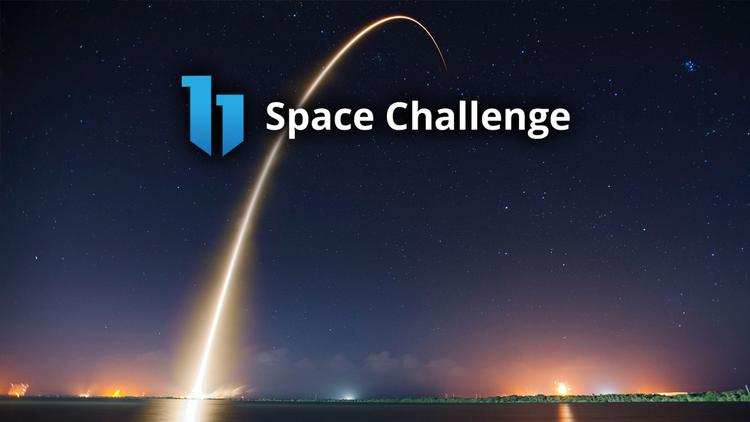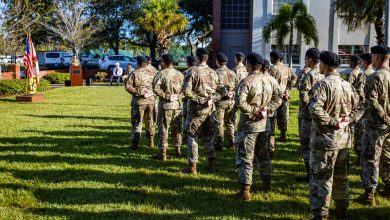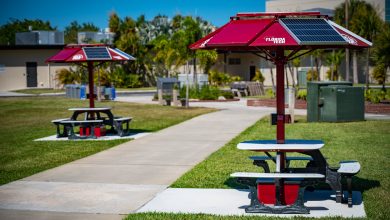With One Million Dollars on the Line, Students Aim Their Rocket Toward the Kármán Line
At 100 kilometers (62 miles) above sea level, the Kármán line is designated the border between Earth’s atmosphere and space. It’s also the goal for 75 passionate and driven Florida Tech students.
Florida Tech Rocketry members will spend the next three years building what they hope will be the first student-built bipropellant rocket to reach the edge of space.
Boldly Going
While the challenge, in itself, is worth the endeavor, the $1 million prize that the Base 11 Space Challenge threw down doesn’t hurt.
Base 11 is a nonprofit organization that is using this aspirational challenge to foster STEM talent in the United States as well as to encourage more representation and inclusion of women and minorities. The nonprofit’s vision is that these kind of stretch-goal missions will empower the future workforce with the education and training necessary for jobs in aerospace and related industries.
“This is a dream opportunity for many of the members and is helping to prepare our members to work in the aerospace industry,” said Karly Lorenzini, chief business officer of Florida Tech Rocketry.
Base 11’s official spokesperson is none other than the man, the myth, the legend: former astronaut Leland Melvin.
You know him. He’s the one whose NASA portrait is the most wholesome, smile-inducing official photo ever taken of an astronaut—maybe of anyone. He’s also the only astronaut to have been drafted by the NFL, but his career was cut short after a few pulled hamstrings. Three years later, he found his way to NASA and into our hearts thanks to his service and, of course, that viral photo.
“The Base 11 Space Challenge is going to help ensure that the next generation of space innovators is just as diverse as America is—all with the excitement of teams flying to the edge of space,” Melvin said in a recent Base 11 press release.
The Spark That Ignited a Mission
So how did 75 students find themselves committing three years of their lives to this very ambitious mission? It all started with the pervasive drive for space exploration woven into Florida Tech’s early history.
“Sixty years ago, Florida Tech’s original nickname was Countdown College, and the influence of that is still present today in the student body,” Lorenzini said. “This summer, a group of friends found out about the Base 11 Space Challenge and created Florida Tech Rocketry. FTR is now a group of students from across three academic colleges, 15 different majors, 10 nations and 15 states.”
For the students working on the rocket, it isn’t just about the prize, but also the hands-on research opportunities it creates for future students.
“Overall, the goals of FTR is to help provide the team members the experience of what working for an aerospace company will be like: learning how to meet deadlines, communicate within different team dynamics and how to ask for help when needed. This mission also has helped to provide the drive to learn these essential skills that are needed in the workforce and has ignited a fire within the team.”
A Quick Lesson on Rocket Science
For rocket engines, there are two propellant types: solid and liquid.
Solid-propellant rockets use solid fuel and oxidizer. Once they are started, they cannot be stopped. Solid-fuel rockets are known for high levels of thrust but poor efficiency.
Liquid-propellant rockets use a liquid fuel and oxidizer, which allows them to be throttled. They are powerful but not as powerful as solid-propellant rockets. However, they are much more efficient.
Liquid-propellant rockets often can swivel their engines to guide the rocket. Both solid- and liquid-propellant rockets can be reused depending on their design.
Rocket scientists often debate which fuel is better. The decision usually comes down to efficiency or thrust. We know where Elon Musk and Jeff Bezos stand. Both SpaceX and Blue Origin use liquid engines in their first and second rocket stages.
Base 11 is motivating students to adopt liquid-fuel engines by incentivizing them to research, prototype and design the first student-built liquid-engine rocket to reach space.
The farthest known flight of a student-built, liquid-engine rocket was 13,000 feet, reported by San Diego State University.
Our students have three years to go 62 miles above the earth.
“During the 2009 Ohio State University commencement, John Glenn, a hero of many people who love space, said ‘We are more fulfilled when we are involved in something bigger than ourselves,’” Lorenzini said. [KH1] “This statement rings true for the members of FTR working to send a rocket to space. The focus and perseverance of the members to achieve this goal has elevated us both as team members and as students.”
From Competitor to Center Stage
Florida Tech’s team represents students from 10 nations and is the only team with a female CEO, Maria Galvez. This level of diversity has already set the Florida Tech team apart.
From the almost 60 university teams participating, Base 11 chose Florida Tech’s team to present the challenge’s overall concept at SOLIDWORKS World 2019.
“Being able to present at SOLIDWORKS was an amazing experience for me,” Galvez said. “I was able to meet and talk with a multitude of leaders in the industry. This moment is a shining example of how the Base 11 Space Challenge has helped to allow for college students to gain experience.”
SOLIDWORKS is one of the nation’s leading CAD software developers. A large component of the Base 11 Space Challenge will be running simulations on 3DEXPERIENCE, a platform provided by Dassault Systèmes, which is the company behind SOLIDWORKS and the reason it’s so impressive that Florida Tech was selected as a presenter at this major conference.
What’s Next?
You’ll have to wait until December 2021 to see who will ultimately take home the $1 million grand prize, but it will be exciting to follow our students’ milestones between now and then.
The next phase of the mission will be a static test fire slated for August 2019 somewhere near campus.
Follow the team on Instagram, @FloridaTechRocket, to stay up to date on its mission milestones.





